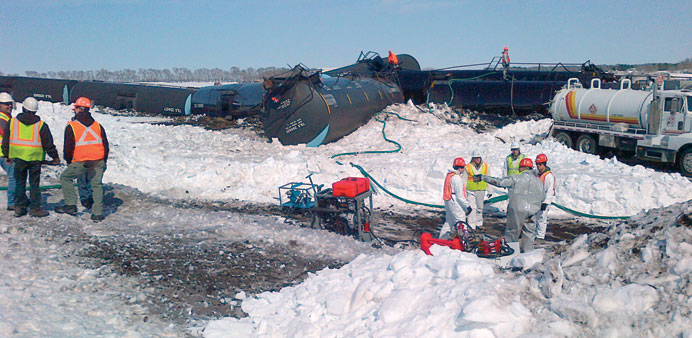Reuters/AFP/New York/Calgary
A mile-long train hauling oil from Canada derailed, spilling 30,000 gallons of crude in western Minnesota on Wednesday, as debate rages over the environmental risks of transporting tar sands across the border.
The major spill, the first since the start of a boom in North American crude-by-rail transport three years ago, came when 14 cars on a 94-car Canadian Pacific train left the tracks about 150 miles northwest of Minneapolis near the town of Parkers Prairie, the Otter Tail Sheriff’s Department said.
No injuries were reported as a result of the derailment, the county sheriff’s office said.
Canadian Pacific Railway Ltd (CP), the country’s second-largest railroad, said only one 26,000-gallon tank car had ruptured, adding it was a mixed freight train.
CP spokesman Ed Greenberg said he did not know if the crude was from Canada’s tar sands or from conventional oil fields.
Minnesota Pollution Control Agency spokesman Dan Olson said up to three tank cars were ruptured and an estimated 20,000 to 30,000 gallons – or 475 to 715 barrels – leaked out.
Cold weather had made the crude thicker, hindering the ability to recover the oil, Olson said, adding the initial clean-up was expected to continue for a day or two.
“We are focusing on drawing up the loose (oil) ... and once that has been taken up, they will then pump up the remaining oil in the tanks,” Olson said. “Because of the winter conditions, the ground is frozen and there is not any damage to surface water or ground water. After the initial recovery we will see if the oil has soaked into the soil at all.”
In an updated statement, CP said just one car was compromised and other two cars leaked while being moved during the response to the derailment and were contained.
Greenburg said that the clean-up efforts were progressing well and without concern. “There have been reports that clean-up has been challenging. Our crews are taking appropriate steps in ensuring clean-up is conducted appropriately.”
A photo provided by the Minnesota Pollution Control Agency showed several large tank cars lying at the side of the railroad tracks in snow-covered fields, as clean-up crews examined the spill and maneuvered pump trucks into position.
“We have options to reroute traffic, so we’ve been able to continue to move trains while we do the thorough job of cleaning up the area,” said Greenberg.
A spokesman for the Federal Railroad Administration said two representatives of the US rail regulator are investigating the incident.
There has been a rapid increase in rail transport of crude in the last three years as booming North American oil production has outgrown existing pipeline capacity.
Canada is the top exporter of crude to the US, due to rising output of crude from its vast tar sands deposits.
Around 40,000 barrels per day (bpd) on average were shipped to the US in 2012, according to data from Canada’s National Energy Board.
Suncor Energy Incorporated, Canada’s largest oil company, pulled the plug on its long-delayed and partially built Voyageur oil sands upgrading project in northern Alberta on Wednesday, citing surging volumes of crude from the Bakken.
Environmentalists have complained about the impact of developing the reserves, and have sought to block TransCanada Corp’s controversial Keystone XL project, which would carry oil produced from the oil sands to the US Gulf Coast refining centre.
Some experts have argued oil-by-rail carries a higher risk of accidents and spills.
“It is good business for the rails and bad safety for the public,” said Jim Hall, a transportation consultant and former chairman of the National Transportation Safety Board. “Railroads travel through population centers. The safest form of transport for this type of product is a pipeline. This accident could – and ought to – raise the issue for discussion.”
Others noted that spills from rail cars are rare, and crude-by-rail has opened up opportunities for companies to develop huge volumes of oil production in places like the Bakken shale fields in North Dakota, which are not well served by pipelines.
Total shipments of petroleum on US railroads rose more than 46% last year to 540,000 carloads, the Association of American Railroads said in January.
“It’s not very good publicity, but railroads are incredibly safe, they don’t spill often,” said Tony Hatch, independent transportation analyst with ABH Consulting in New York who has done work for major railroads. “It should not change the opportunity railroads have to make us more energy independent.”
Supporters of the Keystone XL pipeline were quick to jump on the derailment as a reason to build the pipeline.
“It should be clear that we need to move more oil by pipeline rather than by rail or truck,” said Don Canton, spokesman for North Dakota Senator John Hoeven, who has been one of the chief political proponents of the line. “This is why we need the Keystone XL.”
Hoeven has supported the line as it would help carry oil produced in North Dakota to higher priced refining centres on the coast, and could help further expand production in the state that now pumps more oil than Alaska.

This handout image provided by the Minnesota Pollution Control Agency shows crews working to recover up to 30,000 gallons of crude oil that leaked fro


